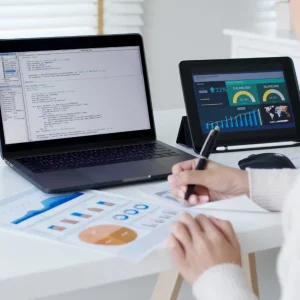
With the global economy in turmoil, incoming earnings reports from technology businesses make for compelling reading.
While news from the trailing quarter still only offers a limited view of how customers are responding to the pandemic, executive sentiment is firmly on show. With it, telling insight into liquidity, headcount and more.
Canada’s Blackberry (still better known in some quarters for the phones it stopped making in 2016) is deep into a hard pivot to security, where it has a broad portfolio, and customers that include all seven members of the G7.
The company outperformed expectations late on Tuesday, wrapping up its fiscal 2020 to report annual revenues (GAAP) of $1.04 billion, up 15 percent year-on-year. (Software and services growth was up 21 percent. Net losses rose to $152 million).
 We Know This Will Pass…”
We Know This Will Pass…”
On the company’s March 31 earnings call CEO John Chen was keen to emphasise that he doesn’t want to “compromise the future” through dramatic cut-backs, and was anticipating being unable to raise more capital in the near term.
He told analysts: “We assume no dramatic cut back of headcount or investment for the future. We’re going to balance profitability and long-term growth. We know this will pass. We know things will come back to normal and we believe we have very competitive strategy and products. So we don’t want to compromise the future.”
Paying off Debt, No New Financing…
Pressed on capital requirements, he said: “We have $385 million of cash or equivalent and so we have made some assumptions under a stress test environment.
“A couple of assumptions. Number one, we will pay back our convert. The good news for paying back our convert is that we would save roughly about $23 million a year in interest payment. Obviously, the cash balance will go down quite a bit. We also assume there is no financing work being done and part of the reason is… the market isn’t really available [although] I think it’s starting to loosen up a little bit.”
Tech Sectors Outlook – Hard to Call, But…
Like others who have reported recently, Blackberry warned that it was nigh impossible to predict sales in calendar 2020, but given its emphasis in protecting remote workers, suggested it may not suffer as badly as many have been.
As Chen put it: “It is not prudent for BlackBerry to provide any specific fiscal 2021 financial outlook as things are changing on almost on a daily basis.
“Negative impact [from headwinds to customers like the auto sector] could be partially offset because our product and services portfolio is well suited to help enterprise to meet the challenges of business continuity driven by the dramatic expansion of remote workers or the number of remote workers,” he added, with a positive spin.
In short: a tough first quarter, a somewhat less grim second quarter, and then, “looking beyond 2021, we do not believe this current global crisis changes BlackBerry’s strategy and the thesis of any of our long-term profitability growth and value creation.”

Chipmakers Stay Positive
A few days earlier, chipmaker Micron’s call also represented a peak behind the scenes. With a surge in need for compute and storage triggered by a rise in remote work, Micron suggested the outlook was far from bleak. The company has taken a sharp look at its supply chain, however, with the aim of boosting flexibility.
CEO Sanjay Mehrotra told investors: “Firstly, we have… taken measures to protect our raw materials supply and increase our supply chain flexibility.
“Second, we have increased our on-hand inventory of raw materials and have begun to store more of that supply on our sites to minimize the impact of any logistics delays. Third, we have increased our focus on multi-sourcing of parts to reduce supplier dependence risk. And fourth, we have added assembly and test capacity… to provide redundant manufacturing capability in multiple regions.”
Sensible precautions, he suggested, because demand showed no signs of drying up. “Data center demand in all regions looks strong and is leading to supply shortages. In addition, we are seeing a recent increase in demand for notebooks used in the commercial and educational segments to support work-from-home and virtual learning initiatives occurring in many parts of the world.”
He added: “We are also encouraged to see manufacturers in China increasingly returning to full production, and we have recently started to see China smartphone manufacturing volumes recover. Nevertheless, as the world deals with the outbreak of COVID-19, we expect that overall demand for smartphones, consumer electronics, and automobiles will be below our prior expectations for the second half of our fiscal 2020. Once the U.S. and other major economies have demonstrated containment of the virus’ spread, we expect a rebound in economic activity.”

 We Know This Will Pass…”
We Know This Will Pass…”




